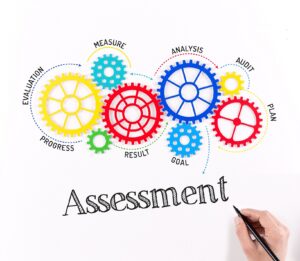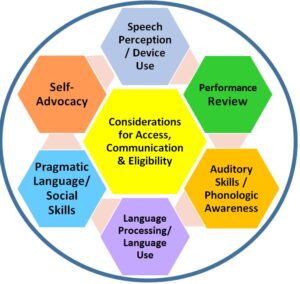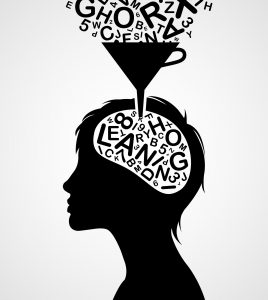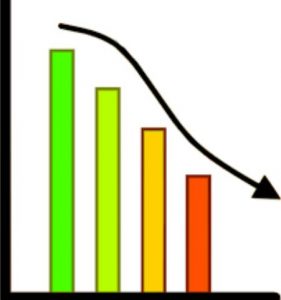Related Products
For Professionals
- Amplification
- Assessment of Student Skills, Challenges, Needs
- Early Childhood: Infants, Toddlers, Preschool
- Hearing Loss – Identification, Impact and Next Steps
- IDEA Law Summary Information
- Language and Speech Development Issues
- Legal Issues in Serving Children with Hearing Loss
- Listening (Auditory Skills) Development
- Planning to Meet Student Needs
- Self-Advocacy Skills for Students with Hearing Loss
- Self-Concept: How the Child with Hearing Loss Sees Himself
- Social Skills
- Speech Perception & Learning
Related Teacher Tools Takeout Items
Assessment Must Go On! Tailored Identification of Access & Educational Needs
Assessment Must Go On!
Tailored Identification of Access & Educational Needs

Despite the challenges of the COVID pandemic, schools remain responsible for offering an equal educational opportunity to students with hearing loss. To do so we must identify and address access issues in online learning situations, along with tailoring assessment to identify a student’s full range of needs. Big questions from the field of education for children with hearing loss include ‘What assessments should we be using?’ and in these trying times, “How can we assess during COVID”
Equal access was already a challenge! The Title II ADA requirement that schools are required to ensure that communication for students who are deaf and hard of hearing are as effective as communication for others [ADA Title II 28 C.F.R. 35.160 (a)(1)] was already a tall order for students who are hard of hearing since it is a fact that no hearing devices in current existence restore normal hearing ability. Even in a classroom setting the provision of hearing assistance technology, interpreter services, and captioning still are often not sufficient to close the access gap. As seen within the CAVE Checklist (Communication Access in Virtual Education) there is no one solution to provide access to students who are hard of hearing or deaf, whether instruction is provided online/remotely or face-to-face. The challenges everyone experiences communicating with masks has underscored the awareness and sensitivity to the challenges of persons who rely on speechreading to boost understanding. Our students require the involvement of a DHH specialist to assist in identifying the access solutions that maximize understanding in whatever instructional situations they face.
| If the creators of IDEA wanted to make it clear that good grades = no IEP they would have clearly done so – but they did not. |
A 2018 US court case1 emphasized that students with hearing loss must receive an eligibility assessment that identifies areas of suspected need secondary to hearing loss with sufficient intensity to satisfy in depth evaluation. The special factors considerations2 also need to be applied throughout the evaluation process. The IDEA law is consistent about looking at educational performance needs when considering a student’s eligibility for specialized instruction and support. Educational performance is not equivalent to academic performance. While academic performance needs to be considered, it is no more important to consider than the other areas specified by IDEA which are functional, behavioral, social needs and any other performance considerations relevant to the specific child.
Our students with hearing loss often have differences/needs that, added together, cause academic performance to erode over time. Even ‘good’ students with hearing loss can qualify IF there is someone on the multidisciplinary team who truly understands the impact of hearing loss on development AND uses appropriate assessments to use to tailor the evaluation process to the risk areas of students with hearing loss. One strong research finding4 was that normative test scores overestimate the abilities of children who are hard of hearing as they are unlikely to reflect the level of effort that students are expending to maintain competitiveness with peers. We must consistently communicate with our school teams that students with hearing loss are not language disordered. Language, social, and reading delays occur secondary to lifelong decreased access to communication.
The defined purpose of IDEA3: To ensure that all children with disabilities have available to them a free and appropriate education that emphasizes special education and related services designed to meet their unique needs and prepare them for further education, employment and independent living. Performance of the expanded core skills needed for full participation (self-advocacy, communication repair, knowledge about hearing loss, amplification independence, etc.) are necessary for a student to be fully prepared to function as an adult. These are NOT standard areas of evaluation for other students with special needs, but they must be considered as part of a tailored assessment for students who are deaf or hard of hearing.
| Go to Teacher Tools Takeout to download Resources for Identifying DHH Student Needs: Eligibility Assessment and Beyond lists of functional and norm-referenced tests. |
 LIST OF RECOMMENDED ASSESSMENTS: The list includes recommendations for both functional and formal assessments for ages 3-5 years and school-age students. In evaluations, it is appropriate to look closely at social/emotional, self-advocacy, and the possibly subtle phonological/morphological awareness and ‘Swiss cheese’ language skills that impact comprehension and reading fluency.
LIST OF RECOMMENDED ASSESSMENTS: The list includes recommendations for both functional and formal assessments for ages 3-5 years and school-age students. In evaluations, it is appropriate to look closely at social/emotional, self-advocacy, and the possibly subtle phonological/morphological awareness and ‘Swiss cheese’ language skills that impact comprehension and reading fluency.
For students with hearing loss to experience equal access, we need to identify barriers first.
Perform a modified Functional Listening Evaluation procedure in an online teaching situation
We know that students with typical hearing respond with 90+% accuracy when listening in noise, even when the noise level is equal to the speech presentation level. It is reasonable to assume that the degradation in sound that occurs when a teacher’s voice is presented over an internet streaming service (like Zoom) will not significantly decrease the speech perception and auditory comprehension ability of students with typical hearing.
 For equal access students with hearing loss should be able to perform with at least 90% accuracy during online learning presentations. Ideally, you will have performed the FLE under classroom conditions and have the percent scores under different listening conditions that can be compared to the following.
For equal access students with hearing loss should be able to perform with at least 90% accuracy during online learning presentations. Ideally, you will have performed the FLE under classroom conditions and have the percent scores under different listening conditions that can be compared to the following.
Suggestions on how to perform this functional check of listening accuracy during online learning:
a. Download and print out the Common Children’s Phrases.
b. Prepare to present Children’s Nonsense Phrases within the Common Children’s Phrases There are 8 lists of 20 items. You can place a + or o next to each sentence to record responses.
c. LIST 1: Use a microphone plugged into your computer as you present and encourage the student to watch your face. Even a standard SmartPhone headset will work with most media devices to improve speech signal clarity. This simulates the best listening condition.
d. LIST 2: Turn off your webcam or do not allow the student to watch your face. Continue to use your microphone. This simulates listening when the teacher is presenting a PowerPoint presentation while livestreaming and her face is not visible.
e. LIST 3: Unplug your microphone and present the list of words in the speechreading condition. These results will indicate how important it is for the student to have the teacher always use a microphone during online learning.
f. LIST 4: Present the nonsense phrases without using the microphone or allowing speechreading. Too many students are currently expected to learn in this situation. With the data you’ve now obtained you can demonstrate the level of barrier to understanding posed by not using a microphone and/or not allowing speechreading.
g. LIST 5 and 6: If you have a mask with a transparent inset available, repeat the conditions with and without using the microphone. This will provide you with some data as to just how important it is for a teacher to use a transparent mask once we return to school, and the potential barrier posed to having the teacher’s face viewed in this manner.
Check comprehension of what the student can hear (or see)
Schools have not been excused from conducting assessment or gathering progress monitoring data. Norm-referenced tests have strict administration protocols. That said, modifications can be made as long as they are referenced in the test report with the caveat that use of the norms may not be as accurate as if the original administration protocol was used.
 For the purposes of students who are deaf or hard of hearing we really want to know how students perform on auditory (or sign interpreted) comprehension tasks relative to their typical class peers. Results will reflect (1) the degree to which hearing loss is posing as a barrier to comprehension along with (2) the impact of any language issues the student may experience. This is true whether the student is face-to-face in a quiet room, or in an online learning situation.
For the purposes of students who are deaf or hard of hearing we really want to know how students perform on auditory (or sign interpreted) comprehension tasks relative to their typical class peers. Results will reflect (1) the degree to which hearing loss is posing as a barrier to comprehension along with (2) the impact of any language issues the student may experience. This is true whether the student is face-to-face in a quiet room, or in an online learning situation.
Suggestions for performing assessment of comprehension of spoken information
a. Gather comprehension data using the Oral Passage Understanding Scale (OPUS) for grades K-12. This test only takes 10-15 minutes to complete. It identifies how well a person can integrate and apply knowledge of use of words and word combinations, grammar and inferential meaning.
b. Gather comprehension data using the Listening Comprehension Test 2 for grades 1-6 or the Listening Comprehension Test Adolescent for grades 7-12. This test assesses comprehension of main idea, listening for details, vocabulary, reasoning and understanding messages. It takes about 30 minutes to administer.
c. Conduct an Informal Evaluation of Auditory Comprehension of Information with and without Accommodations. This functional assessment procedure refers to how to conduct comparison testing in a typical classroom environment (or simulated classroom noise vs. quiet). Adapt the procedure to online learning by reading a story and answering comprehension questions with and without a microphone, with and without speechreading, speechreading through a mask, with and without captioning, etc.
d. For hard of hearing students DO NOT ALLOW SPEECHREADING as this is an inconsistent listening condition.
e. If a HAT (FM/DM system) is typically used with the student be sure to use it while performing comprehension assessments.
f. If captioning is typically used during instruction it can be used while performing the assessments.
g. For students who are Deaf and use an interpreter, if at all possible, have the interpreter the student uses in the classroom setting interpret what you say during testing. Allow the student to view your face and the interpreter so the student’s ‘triangle of communication’ is as typical as possible.
Although testing is performed in a few weeks’ time, evaluation isn’t just about a snap shot, it is about performance over time.
 Case in point: a child had an IEP in kindergarten and grade 1 and was then dismissed. By the end of grade 4 reading scores had decreased. The school team wasn’t concerned because the student ‘wasn’t very bad yet. When looking at eligibility, dig into prior testing and see if there is evidence of declining percentile ranking in test results over time. For example, in grade 2 the child scored at the 48th percentile in reading as compared to the 26th percentile in grade 4. A public agency must provide a child with a disability special education and related services to enable him or her to progress in the general curriculum. The fact that there is a decline indicates that there are special needs that have not been addressed for the student. Access needs and/or deficits in specific skills foundational to reading comprehension would then need to be identified.
Case in point: a child had an IEP in kindergarten and grade 1 and was then dismissed. By the end of grade 4 reading scores had decreased. The school team wasn’t concerned because the student ‘wasn’t very bad yet. When looking at eligibility, dig into prior testing and see if there is evidence of declining percentile ranking in test results over time. For example, in grade 2 the child scored at the 48th percentile in reading as compared to the 26th percentile in grade 4. A public agency must provide a child with a disability special education and related services to enable him or her to progress in the general curriculum. The fact that there is a decline indicates that there are special needs that have not been addressed for the student. Access needs and/or deficits in specific skills foundational to reading comprehension would then need to be identified.
Educational programs must be reasonably calculated to enable a child to make progress appropriate in light of the child’s circumstances. In the case of students with hearing loss, the expectation would be to provide full access to school communication and specialized instruction to fill in learning gaps PLUS support typical/expected levels of progress in the classroom. Therefore, evaluation must be tailored to identify the access, learning, and functional performance needs of every student with hearing loss so that they can progress equal to their cognitive peers, regardless of online or onsite instruction.
References
- 1. Ninth Circuit Court of Appeals, June 1, 2018, S.P. v. East Whittier City School District: https://successforkidswithhearingloss. com/wp-content/uploads/2019/01/Court-case-RE-need-for-thorough-assessment-highlighted.pdf
- 2. IDEA section 300.324(2)(iv): Consider the communication needs of the child, and in the case of a child who is deaf or hard of hearing, consider the child’s language and communication needs, opportunities for direct communications with peers and professional personnel in the child’s language and communication mode, academic level, and full range of needs, including opportunities for direct instruction in the child’s language and communication mode.
- 3. The 2004 IDEA Commentary provides an overall ‘setting the stage’ for the IDEA law; on this webpage.
- 4. Epilogue: Conclusions and Implications for Research and Practice. Ear and Hearing, 36, 92S-98S. Sole reliance on norm-referenced scores may overestimate the outcomes ofCHH. When the children who are hard of hearing (CHH) were compared with the norm-referenced group on various measures, the differences were small. However, when compared the CHH to a sample of CNH who were matched on age and SES, the size of the effect of HL on language doubled to two thirds of a standard deviation. These results question the sole reliance on comparison to norm-referenced test scores for judging eligibility. Standardized test scores may overestimate CHH as they are unlikely to reflect the level of effort that students are expending (cognitive and perceptual resources) to maintain competitiveness with peers in secondary schooling, where the cognitive demands increase. We need to closely monitor the outcomes of CHH including comparing their performance relative to neighborhood grade-mates. Many CHH in the OCHL study represent the best-case scenario. We might expect that a sample with greater diversity on these dimensions would not perform as well as the OCHL cohort.
Karen L. Anderson, PhD, Director, Supporting Success for Children with Hearing Loss; 2020 Early Oct Update.
This information is not intended as legal advice. http://successforkidswithhearingloss.com
Sign up to receive Bimonthly Updates from Supporting Success.
